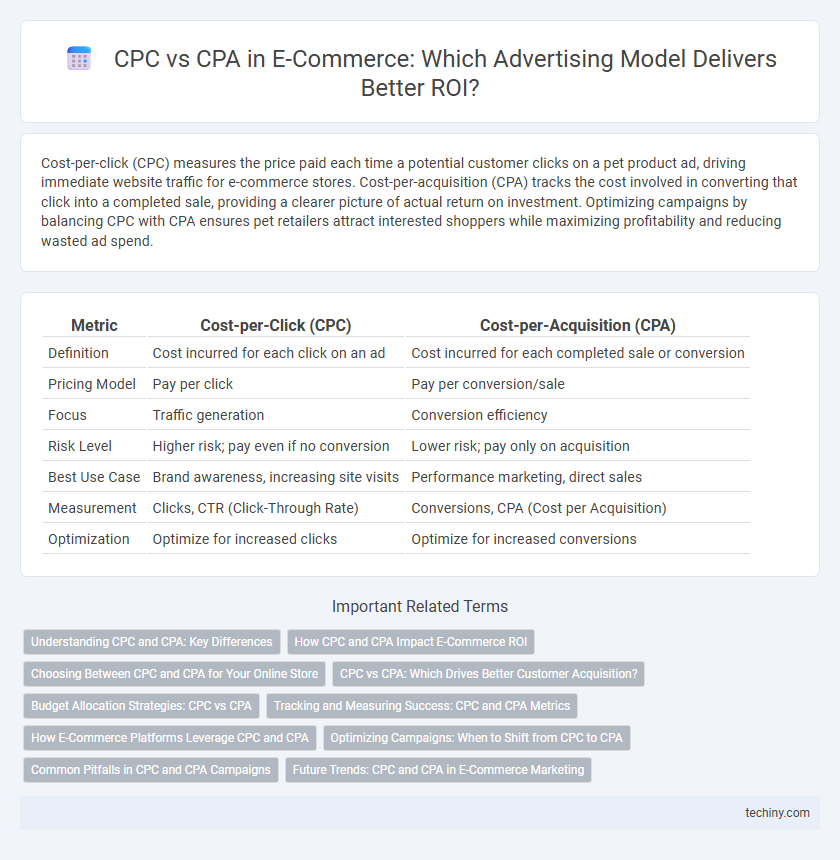Cost-per-click (CPC) measures the price paid each time a potential customer clicks on a pet product ad, driving immediate website traffic for e-commerce stores. Cost-per-acquisition (CPA) tracks the cost involved in converting that click into a completed sale, providing a clearer picture of actual return on investment. Optimizing campaigns by balancing CPC with CPA ensures pet retailers attract interested shoppers while maximizing profitability and reducing wasted ad spend.
Table of Comparison
| Metric | Cost-per-Click (CPC) | Cost-per-Acquisition (CPA) |
|---|---|---|
| Definition | Cost incurred for each click on an ad | Cost incurred for each completed sale or conversion |
| Pricing Model | Pay per click | Pay per conversion/sale |
| Focus | Traffic generation | Conversion efficiency |
| Risk Level | Higher risk; pay even if no conversion | Lower risk; pay only on acquisition |
| Best Use Case | Brand awareness, increasing site visits | Performance marketing, direct sales |
| Measurement | Clicks, CTR (Click-Through Rate) | Conversions, CPA (Cost per Acquisition) |
| Optimization | Optimize for increased clicks | Optimize for increased conversions |
Understanding CPC and CPA: Key Differences
Cost-per-click (CPC) charges advertisers based on the number of clicks their ads receive, emphasizing traffic generation to e-commerce sites. Cost-per-acquisition (CPA) measures the actual cost incurred for each completed purchase or conversion, prioritizing sales and ROI. Understanding these key differences helps e-commerce businesses optimize ad spend by balancing traffic volume with conversion efficiency.
How CPC and CPA Impact E-Commerce ROI
Cost-per-click (CPC) directly affects e-commerce ROI by controlling the initial customer engagement cost, influencing traffic volume quality and budget allocation. Cost-per-acquisition (CPA) offers a precise measure of ROI by focusing on actual conversions, ensuring marketing spend aligns with revenue generation. Optimizing both CPC and CPA strategies enhances overall profitability by balancing traffic costs with the conversion rate efficiency.
Choosing Between CPC and CPA for Your Online Store
Choosing between Cost-per-click (CPC) and Cost-per-acquisition (CPA) for your online store depends on your specific marketing goals and budget allocation. CPC is ideal for driving high volumes of traffic, allowing you to optimize ads for clicks and increase brand visibility, while CPA focuses on paying only when a sale or conversion occurs, making it cost-effective for direct revenue tracking. Evaluating your conversion rates, average order value, and customer acquisition cost will help determine which pricing model yields the best return on investment for your e-commerce campaigns.
CPC vs CPA: Which Drives Better Customer Acquisition?
Cost-per-click (CPC) drives more traffic by charging for each click on ads, making it effective for increasing brand exposure and testing campaigns, while Cost-per-acquisition (CPA) focuses on paying only for completed sales or conversions, optimizing budget towards tangible customer acquisition. CPC offers immediate user engagement metrics, but CPA directly ties marketing spend to actual customer actions, often yielding a higher return on investment in e-commerce growth. Analyzing campaign goals and sales funnel stages helps determine whether CPC's broad reach or CPA's conversion focus better drives efficient and scalable customer acquisition.
Budget Allocation Strategies: CPC vs CPA
Budget allocation strategies in e-commerce pivot on balancing Cost-per-click (CPC) and Cost-per-acquisition (CPA) metrics to optimize return on investment. Prioritizing CPC maximizes traffic inflow by paying for clicks regardless of conversion, beneficial for brand awareness campaigns with broad reach. Focusing budget on CPA aligns spending directly with conversions, ideal for targeted campaigns aiming to minimize cost per sale and enhance profitability.
Tracking and Measuring Success: CPC and CPA Metrics
Cost-per-click (CPC) measures the cost for each user click on an ad, providing insights into traffic generation efficiency but not necessarily conversion effectiveness. Cost-per-acquisition (CPA) tracks the expense associated with acquiring a paying customer, directly reflecting return on investment (ROI) and campaign profitability. Utilizing both CPC and CPA metrics enables e-commerce businesses to optimize ad spend by balancing traffic volume with actual sales performance for comprehensive success measurement.
How E-Commerce Platforms Leverage CPC and CPA
E-commerce platforms strategically leverage Cost-per-click (CPC) to drive targeted traffic by optimizing ad placements and bidding on relevant keywords to increase visibility and engagement. Cost-per-acquisition (CPA) is used to measure the effectiveness of these campaigns by tracking conversions such as sales or sign-ups, allowing platforms to allocate budget toward channels that deliver the highest return on investment. By balancing CPC for traffic generation with CPA for conversion efficiency, e-commerce businesses enhance marketing performance and maximize customer acquisition value.
Optimizing Campaigns: When to Shift from CPC to CPA
Optimizing e-commerce campaigns involves evaluating key performance indicators such as Cost-per-click (CPC) and Cost-per-acquisition (CPA) to maximize return on ad spend. Shifting from CPC to CPA becomes advantageous when conversion tracking data reveals consistent purchase patterns, allowing advertisers to pay specifically for valuable customer actions rather than mere traffic. This transition enhances budget efficiency by focusing on profitability metrics, improving campaign targeting, and driving higher sales volume through acquisition-focused strategies.
Common Pitfalls in CPC and CPA Campaigns
Common pitfalls in CPC campaigns include overemphasis on low click costs without considering conversion quality, leading to wasted budget on irrelevant traffic. CPA campaigns often suffer from inaccurate tracking and attribution, causing misjudgment of actual acquisition costs and inefficient spend allocation. Both strategies require continuous optimization through data analysis to avoid inflated costs and maximize return on investment in e-commerce marketing.
Future Trends: CPC and CPA in E-Commerce Marketing
Future trends in e-commerce marketing reveal a growing shift towards cost-per-acquisition (CPA) models as businesses prioritize measurable returns over mere clicks, optimizing budget efficiency. Advances in AI and machine learning enable more precise targeting and attribution, enhancing CPA effectiveness and reducing reliance on cost-per-click (CPC) campaigns. Integration of cross-channel analytics further supports dynamic bidding strategies, allowing marketers to balance CPC and CPA metrics for maximum customer acquisition and revenue growth.
Cost-per-click (CPC) vs Cost-per-acquisition (CPA) Infographic

 techiny.com
techiny.com